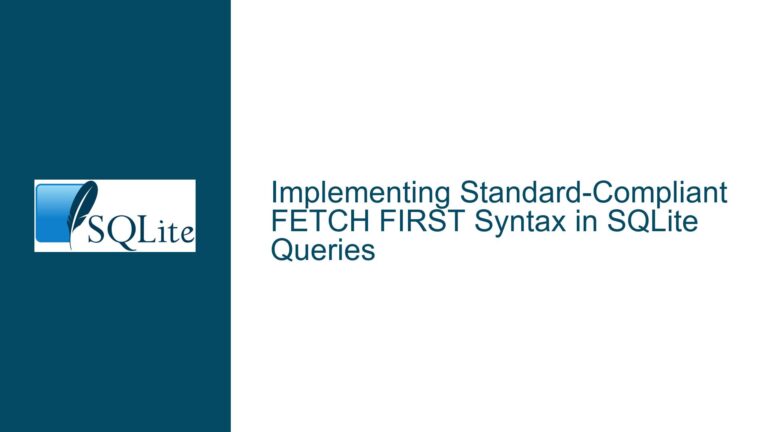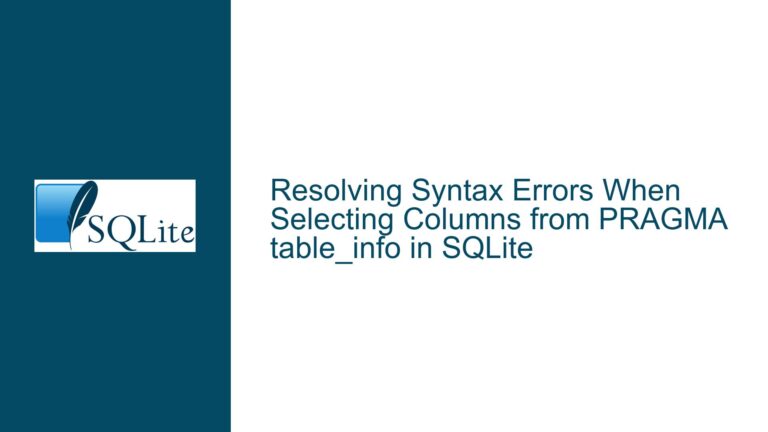SQLite NULL Handling Issue in LEFT JOIN with Query Flattening Optimization
NULL Values Misinterpreted in LEFT JOIN Results
The core issue revolves around the misinterpretation of NULL values in SQLite when performing a LEFT JOIN operation, particularly under specific conditions involving query flattening optimization. This problem manifests when NULL values, which should logically represent missing or non-existent data from the right table in a LEFT JOIN, are not being treated as NULL. Instead, they are being handled in a way that suggests they have a non-NULL value, leading to incorrect query results and potential logical errors in applications relying on this behavior.
The issue was first observed in SQLite version 3.33.0, where a user reported that NULL values resulting from missing rows in a LEFT JOIN were not being treated as NULL. This behavior was not reproducible in an earlier version, SQLite 3.21.0, indicating a regression or a newly introduced bug in the newer version. The problem was particularly perplexing because NULL handling is a fundamental aspect of SQL operations, and any deviation from expected behavior can have significant implications for data integrity and application logic.
The user provided a detailed Jupyter notebook illustrating the problem, along with the associated database, to help diagnose the issue. The notebook demonstrated that under certain conditions, the NULL values produced by the LEFT JOIN were not being recognized as NULL, leading to unexpected results in subsequent operations. This behavior was traced back to the interaction between the LEFT JOIN operator and the query flattening optimization, a performance-enhancing feature in SQLite that rewrites subqueries to improve execution efficiency.
Query Flattening Optimization and LEFT JOIN Interaction
The root cause of the issue lies in the interaction between the query flattening optimization and the LEFT JOIN operator in SQLite. Query flattening is an optimization technique used by SQLite to improve the performance of queries involving subqueries. It works by rewriting subqueries to eliminate unnecessary nesting, thereby reducing the computational overhead and improving execution speed. However, this optimization can sometimes lead to unexpected behavior, especially when combined with complex operations like LEFT JOINs.
In the case of the reported issue, the query flattening optimization was interfering with the proper handling of NULL values in the results of a LEFT JOIN. Specifically, the optimization was causing the NULL values produced by the LEFT JOIN to be misinterpreted, leading to incorrect query results. This behavior was not present in earlier versions of SQLite, suggesting that the issue was introduced as a side effect of changes made to the query flattening optimization in version 3.33.0.
The problem was further exacerbated by the fact that the misinterpretation of NULL values was not immediately apparent. In many cases, the incorrect handling of NULLs would only manifest under specific conditions, making it difficult to diagnose and reproduce. This subtlety added to the complexity of the issue, as it required a deep understanding of both the SQLite query execution engine and the specific conditions under which the problem occurred.
The issue was eventually traced back to a specific bug in the query flattening optimization that was introduced in version 3.33.0. This bug caused the optimization to incorrectly handle NULL values in certain scenarios, particularly when combined with LEFT JOINs. The bug was identified and fixed in the SQLite trunk, but the fix had not yet been propagated to the official releases at the time of the report.
Implementing PRAGMA journal_mode and Database Backup Strategies
To address the issue of NULL values being misinterpreted in LEFT JOIN results, several troubleshooting steps and solutions can be implemented. The first and most immediate solution is to apply the fix that was introduced in the SQLite trunk. This fix addresses the specific bug in the query flattening optimization that was causing the incorrect handling of NULL values. Users who are experiencing this issue should consider updating to a version of SQLite that includes this fix once it becomes available in an official release.
In the meantime, users can work around the issue by modifying their queries to avoid the specific conditions that trigger the bug. One approach is to disable the query flattening optimization for the affected queries. This can be done by using the PRAGMA command to set the query_flattening option to 0 before executing the query. This will prevent SQLite from applying the query flattening optimization, thereby avoiding the incorrect handling of NULL values. However, this approach may result in a performance penalty, as the query flattening optimization is designed to improve query execution speed.
Another workaround is to use a different type of join or query structure that does not rely on the LEFT JOIN operator in combination with the query flattening optimization. For example, users could consider using an INNER JOIN or a UNION operation to achieve the same result without triggering the bug. This approach may require rewriting the query logic, but it can be an effective way to avoid the issue until a fixed version of SQLite is available.
In addition to these workarounds, users should also consider implementing robust database backup strategies to protect against data corruption and other issues that may arise from unexpected behavior in SQLite. One effective strategy is to use the PRAGMA journal_mode command to enable the WAL (Write-Ahead Logging) mode. WAL mode provides better concurrency and crash recovery compared to the default rollback journal mode, making it a more reliable option for databases that are frequently updated.
To enable WAL mode, users can execute the following command:
PRAGMA journal_mode=WAL;
This command will switch the database to WAL mode, which can help prevent data corruption in the event of a crash or power failure. Additionally, users should regularly back up their databases using the .backup command or a similar tool to ensure that they have a recent copy of their data in case of an issue.
Finally, users should stay informed about updates and bug fixes in SQLite by regularly checking the official SQLite website and forums. By keeping up to date with the latest developments, users can ensure that they are using the most stable and reliable version of SQLite available. This proactive approach can help prevent issues like the NULL handling bug from affecting their applications and data.
In conclusion, the issue of NULL values being misinterpreted in LEFT JOIN results in SQLite is a complex problem that requires a deep understanding of the query execution engine and the specific conditions under which the issue occurs. By applying the fixes and workarounds outlined above, users can mitigate the impact of this issue and ensure the integrity of their data and applications. Additionally, implementing robust database backup strategies and staying informed about updates and bug fixes can help prevent similar issues from arising in the future.






